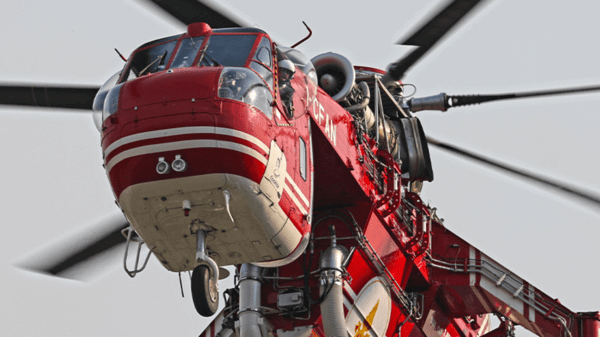Gallery: Battling winter forest fires

Although wildfires are more common in summer months, Dino Marcellino was able to report on aerial firefighters responding to forest fires in the Italian Alps in winter
Forest fires in Italy are recurrent events, happening mainly in summer months and in the southern regions. However, wildfires are not restricted to this season or location; a lot of fires flare up in the northwest of Italy such as in the Alpine area of Piedmont during the autumn and winter months, mostly as a result of drought and strong seasonal hot winds called ‘foehn’.
Unlike summer conflagrations, winter forest wildfires are rarely spontaneous natural events, instead caused by people – through arson or accident. Winter 2023/24 was no exception, with up to four simultaneous fires in the Piedmont area alone days before the Christmas holidays.
Each of the 20 Italian regions is responsible for organizing its own forest firefighting service, both on ground and from the air. In Piedmont, the Regional Authority manages a system for the forecast and assessment of the danger of forest fires. The prediction of the fire danger from analysis of data, such as meteorological conditions and humidity, allows it to organize fire prevention, optimize intervention and inform the public of the danger.
The anti incendio boschivo (AIB; forest firefighting) volunteers form the backbone of ground intervention; a lot of towns and villages have a local AIB station with a team equipped with off-road cars, tools, water tankers, and mobile water basins.
Air assets are provided locally by private operators on the basis of a public tender. The helicopters used are mainly light, such as the AS350 Écureuil, for reasons of lower cost, flexibility and maneuverability, especially in the narrow spaces often found in Alpine valleys. The operators have to dispatch them rapidly when requested by the authorities, equipped with buckets and assisted by the operators’ tankers to refuel the craft.
If the regional service and the local helicopter fleet are unable to cope with an uncontrollable fire, the regional operations room can ask the national emergency room in Rome for the intervention of the heavy aircraft fleet managed at national level by the Centro Operativo Aereo Unificato (COAU; Joined Operative Air Centre).
The national fleet is made up of both fixed- and rotary-wing aircraft: Canadair CL-415s and Erickson S-64Fs. These craft are officially part of the Vigili del Fuoco air fleet but are assigned to territories by the COAU; they are strategically placed throughout the Italian peninsula and larger islands, primarily based near where fires statistically happen most often. However, the CL-415 (as a scooper) is then preferentially placed near the sea or great lakes rather than the smaller bodies of water that can be accessed by the S-64Fs.
In this gallery, the aircraft fighting the winter forest fires in Piedmont include Canadair CL-415s and Erickson S-64s from the Vigili del Fuoco air fleet, and AS350 Écureuils operated by Heliwest.

April 2024
Issue
In the April special aerial firefighting edition, learn about the techniques and tools being employed; find out about the diverse capabilities of uncrewed aerial vehicles; see how the European Union is consolidating resources; review the damage that Australia has suffered from bushfires; explore Indonesian search and rescue processes; and consider if your helmet is due for a service or replacement; plus more of our regular content.
Dino Marcellino
Known around the world for his aviation photography and reports, Dino Marcellino has been fascinated by aircraft since his childhood, and has spent his life combining his passion for aircraft with that of photography. Flying on more than 25 different types of helicopters, he has worked with the Italian Navy, Army and Air Force, as well as police and rescue organisations.






